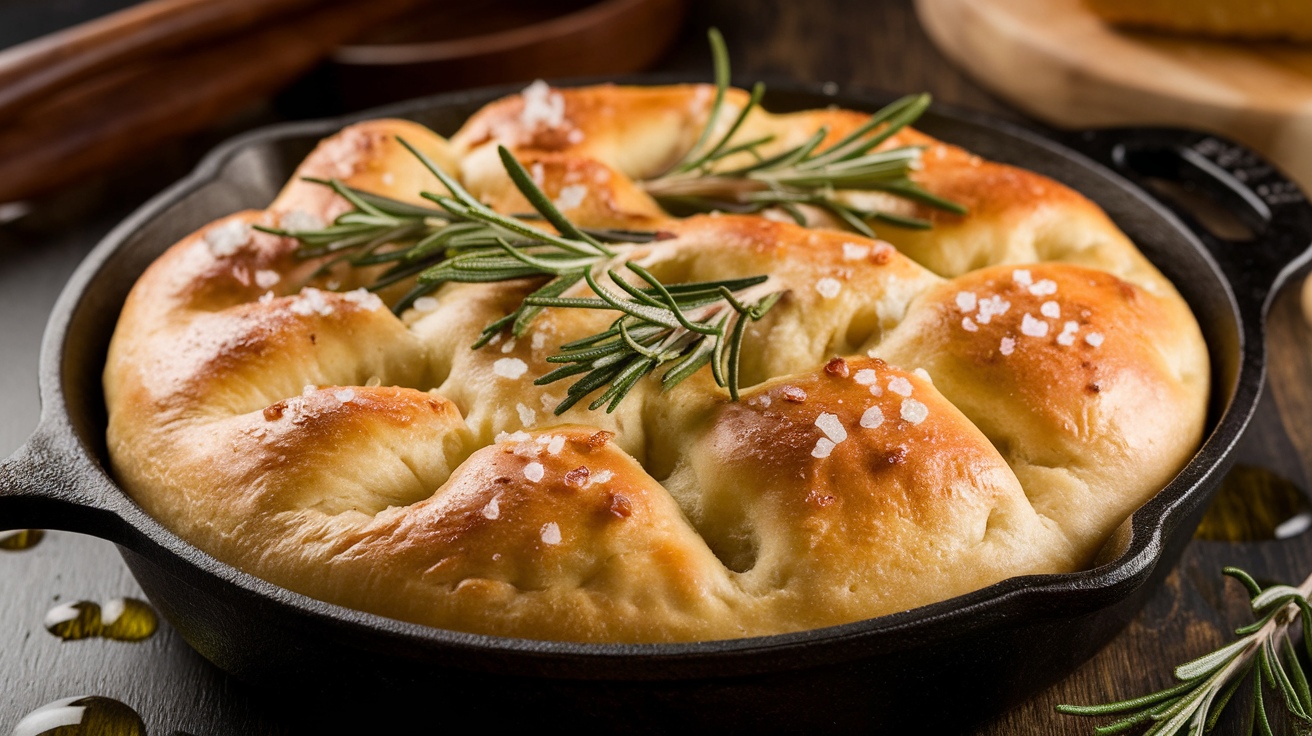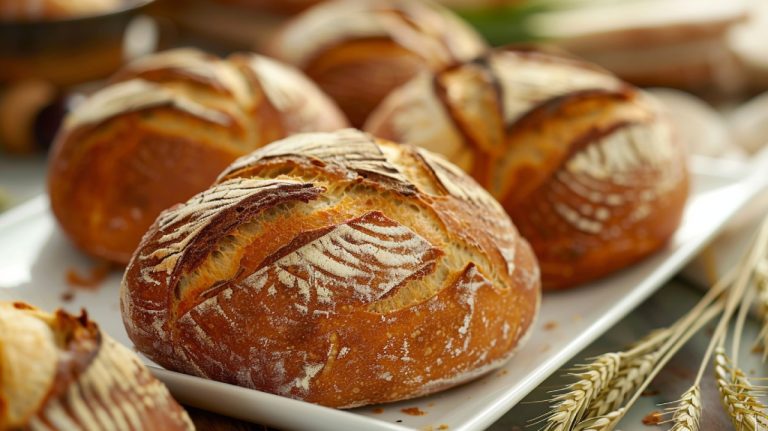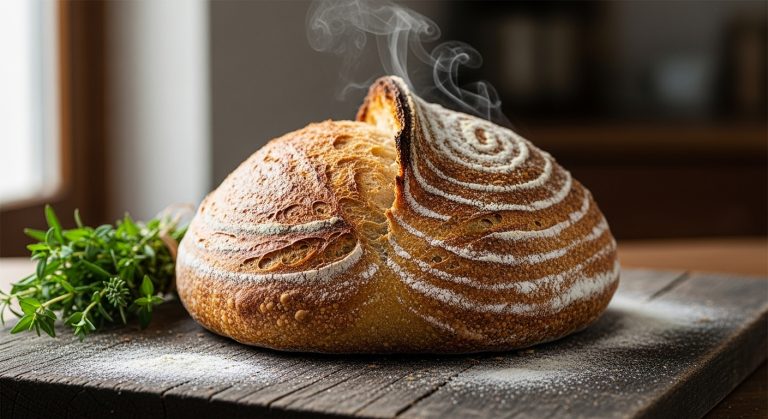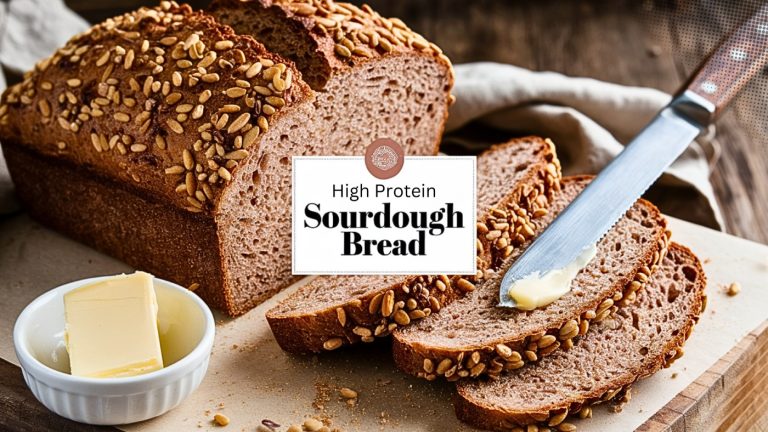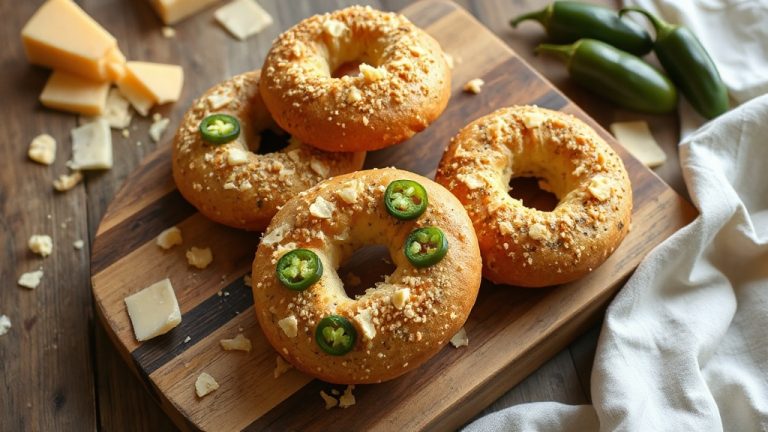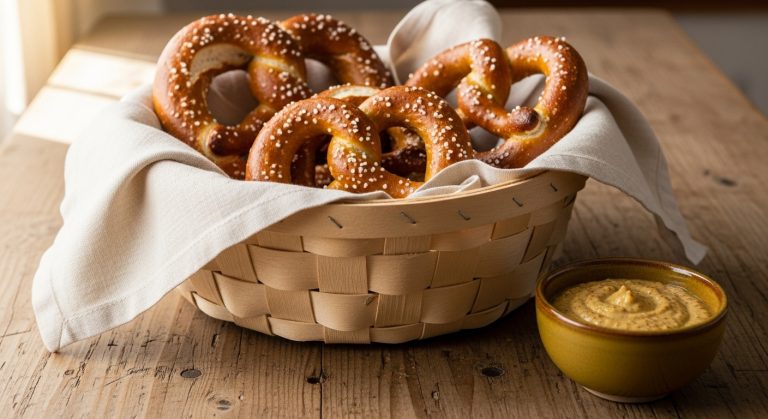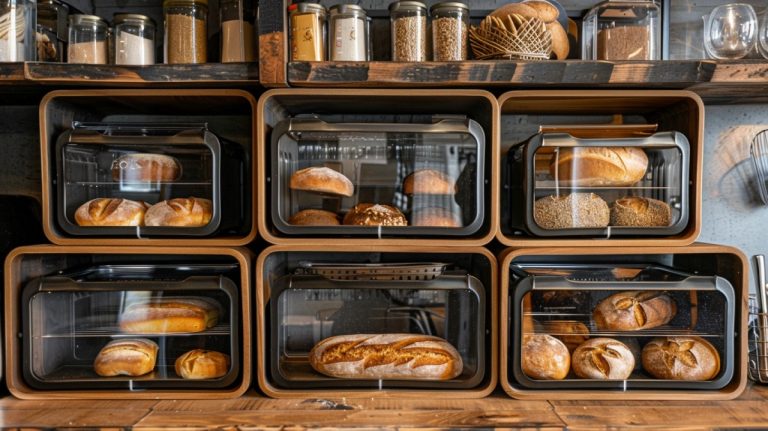Can You Bake Focaccia in a Cast Iron Skillet?
You can bake focaccia in a cast iron skillet. This method gives you a perfectly crispy crust and a fluffy interior, thanks to the skillet’s even heat distribution.
You’ll enjoy a beautifully risen focaccia, enhanced by the pan’s high sides. Mix your dough, let it rise, and then transfer it to the oiled skillet. Don’t forget to create dimples for oil and seasonings!
Bake until it’s golden brown, and you’ll be rewarded with a delightful bread that’s great for sandwiches or as a side. There’s so much more to discover about perfecting your focaccia.
Key Takeaways
- Yes, baking focaccia in a cast iron skillet ensures even heat distribution for a crispy crust and fluffy interior.
- The high sides of the skillet allow for a thicker focaccia that rises beautifully during baking.
- Preheating the cast iron skillet enhances the focaccia’s crust texture and overall flavor.
- Cast iron skillets retain heat exceptionally well, promoting better browning and rise of the focaccia.
- The skillet’s durability makes it an ideal tool for baking focaccia, providing easy cleanup and maintenance.
Benefits of Cast Iron Focaccia
When you bake focaccia in a cast iron skillet, you’re not just choosing a vessel but revealing a culinary advantage. The even heat distribution of a cast iron skillet guarantees that your focaccia develops a perfectly crispy crust while maintaining a fluffy interior.
Unlike a flat baking sheet, the high sides of the skillet contain the dough, allowing for a thicker focaccia that rises beautifully. This process benefits from the steam created when preheating the skillet, which enhances the dough’s oven spring and crust texture, similar to how steam plays a vital role in sourdough baking.
The exceptional heat retention of cast iron promotes a better rise and enhances browning, elevating your focaccia to new heights. Plus, you can preheat the skillet before adding the dough; this technique creates a steam effect, resulting in an airy texture and an improved crust formation.
What’s more, a cast iron skillet offers unmatched versatility in baking. You can start on the stovetop with techniques like sautéing garlic or infusing herbs before transferring them to the oven and adding layers of flavor.
Essential Ingredients for Focaccia
To create the perfect focaccia, you’ll need just a handful of essential ingredients to produce this delightful bread. Start with high-quality all-purpose flour; it provides the necessary structure and rise for your dough. Next, grab some active dry yeast, which is vital for leavening.
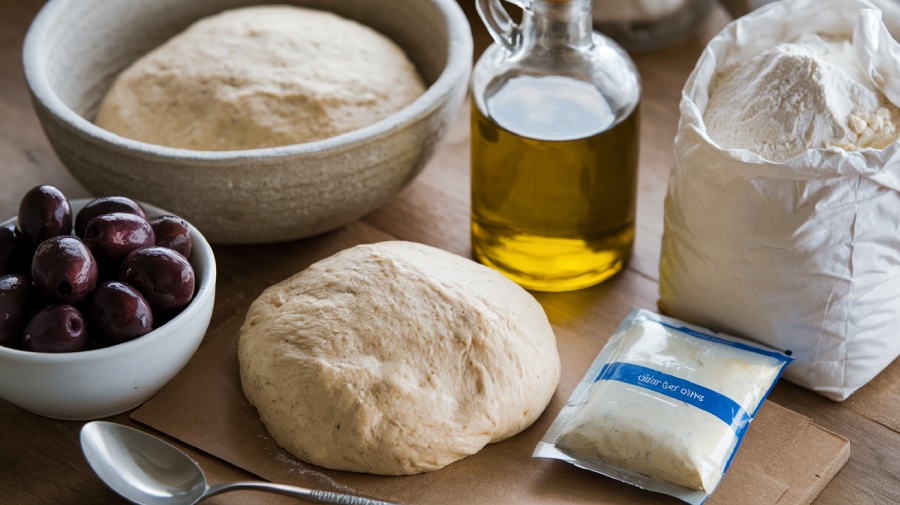
Mixing it with warm water and a touch of sugar activates and creates bubbles, helping your dough rise beautifully. Additionally, using a robust sourdough starter can enhance the flavor and texture, making your focaccia even more irresistible, as seen in sourdough focaccia pizza.
To enhance the flavor of your focaccia, add extra-virgin olive oil to add moisture and richness. Drizzling it on top before baking gives the bread a delightful, golden crust. Kosher salt is a must for seasoning; it guarantees your focaccia is well-seasoned and bursting with flavor.
Also, consider incorporating fresh rosemary. This aromatic herb can be mixed into the dough or sprinkled on top, adding a distinctive touch that elevates your focaccia to another level.
Step-by-Step Focaccia Preparation
The joy of baking focaccia begins with carefully preparing your dough, transforming simple ingredients into a delightful masterpiece. Mix flour, salt, sugar, and activated yeast with warm water until you have a shaggy dough. Let this dough rise for about 3 hours, allowing it to double in size.
Once the dough has risen, transfer it to a well-oiled cast iron skillet. Spread it out gently to fit the pan, and let it rest for 1-2 hours until it reaches the edges. If your recipe calls for it, preheat your oven to 425°F or 450°F.
Now, it’s time to dimple the dough. Use your fingertips to create little pockets across the surface to hold the olive oil and seasonings. Drizzle generously with olive oil and sprinkle some flaky sea salt or your favorite herbs on top.
Bake the focaccia for 20-25 minutes, turning the skillet halfway through for even cooking. When it’s golden brown and crispy, pull it out and let it cool for about 15 minutes before slicing and serving with more olive oil or balsamic vinegar for dipping.
Tips for Dough Handling
When you’re handling focaccia dough, a little oil on your hands goes a long way to prevent sticking and keep it moist. Use a gentle stretching and folding technique during rising; it helps develop gluten without the need for vigorous kneading. Remember to let the dough rest in the skillet until it fills the pan, creating that perfect texture you crave.
Proper Dough Handling Techniques
Handling dough properly is essential for achieving that perfect focaccia texture. Start by lightly coating your hands and working surface with olive oil. This prevents the sticky dough from clinging to everything, making your dough handling smoother. Use gentle stretching and folding techniques; this way, you maintain the dough’s structure without overworking it, which helps retain those precious air bubbles vital for a light, airy focaccia.
When you transfer the dough to your cast iron skillet, allow it to rest for a few minutes. This little pause lets the gluten relax, making it easier to spread the dough evenly to reach the edges of the pan. Before baking, create dimples in the dough using your fingertips. Not only do these dimples add appealing texture, but they also promote better absorption of olive oil and toppings, enhancing flavor.
Rising and Shaping Tips
Achieving the perfect rise and shape for your focaccia starts with creating the right environment for your dough. Allow your dough to rise at room temperature, covering it with plastic wrap or a damp cloth to retain moisture. This process usually takes about 1 to 3 hours, giving the dough time to double in size.
When it’s time to shape the dough, gently stretch it to fit your cast iron skillet without deflating it excessively. Aim for an even thickness throughout to guarantee uniform baking. Once you’ve pressed the dough into the skillet, let it rise for another 1 to 2 hours. This step allows the dough to puff up and reach the edges of the pan, creating that signature focaccia texture.
Before baking, dimple the surface with your fingertips. This not only adds character but also helps retain olive oil and toppings, enhancing both flavor and moisture. Finally, preheat the oven to 425°F (or 450°F, depending on your recipe) before placing the skillet inside. This guarantees a good rise and a crispy crust, making your focaccia irresistible.
Baking Techniques for Success
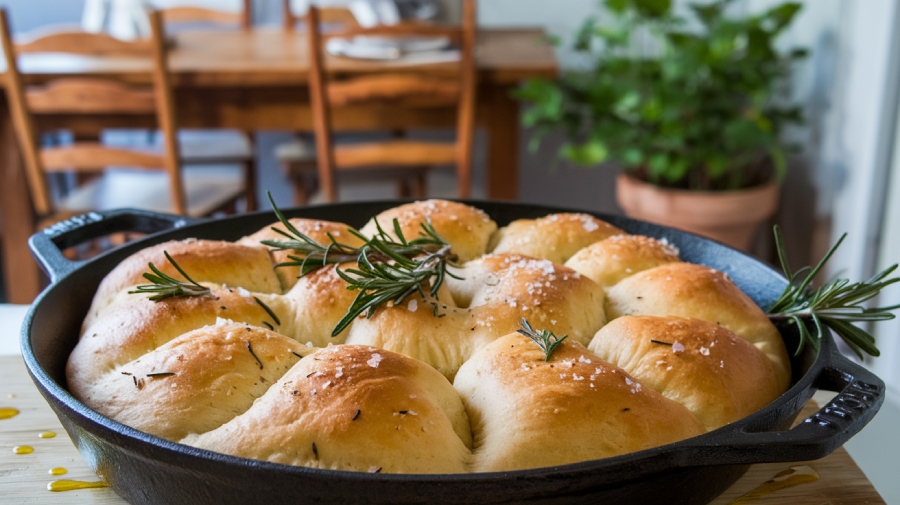
Mastering the right baking techniques is essential to guaranteeing your focaccia turns out perfectly. Using a cast iron skillet not only enhances the crust but also helps distribute heat evenly. Start by preheating your skillet in the oven, making sure it’s hot enough to create a crispy exterior. Generously coat the bottom with olive oil before adding your dough to prevent sticking and boost flavor.
Once your dough is in the skillet, use your fingertips to create dimples across the surface. This not only helps retain oil but also adds delightful texture to your focaccia. Bake at a high temperature, around 425°F to 450°F, for 20-25 minutes. This guarantees your bread rises beautifully and develops a golden-brown crust.
After baking, resist the urge to slice right away! Allow your focaccia to rest for about 15 minutes. This resting period helps firm up the structure, making it easier to cut and enhancing the overall texture.
Here’s a quick summary of the key techniques:
| Technique | Description | Purpose |
|---|---|---|
| Preheat Skillet | Heat the cast iron skillet before baking. | Guarantees even heat and crust. |
| Generously Oil | Coat skillet with olive oil before adding dough. | Prevents sticking, adds flavor. |
| Create Dimples | Use fingertips to dimple the dough. | Retains oil, enhances texture. |
| Rest After Baking | Let focaccia sit for 15 minutes post-baking. | Improves structure and texture. |
Flavor Variations and Toppings
Flavor variations and toppings can truly elevate your focaccia, turning a simple bread into a culinary delight. You have endless options to customize your focaccia, enhancing its flavor profile with fresh herbs and toppings. Consider mixing in olive oil, sea salt, or a sprinkle of garlic to create a savory base.
Fresh rosemary is a classic choice, but don’t hesitate to experiment with thyme, oregano, or basil for unique notes. Adding seasonal ingredients like butternut squash can also bring a delightful sweetness that complements the savory flavors.
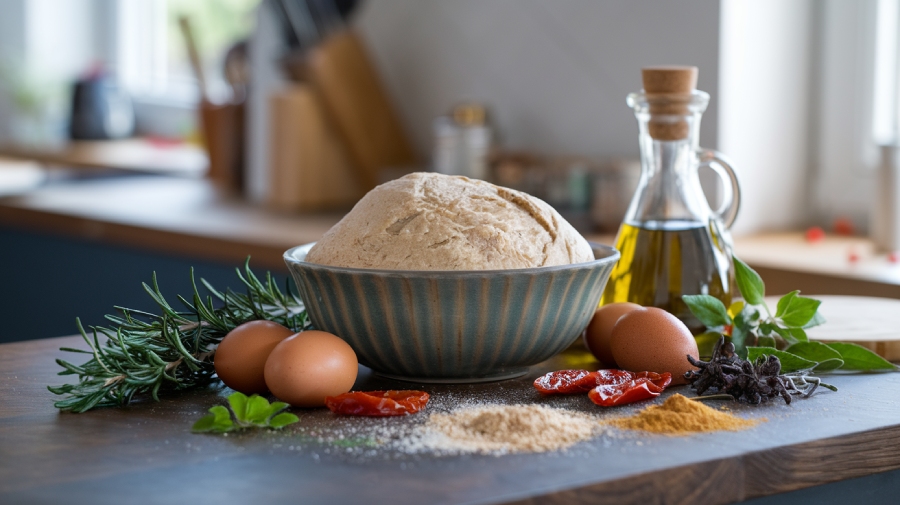
Try adding sliced tomatoes or caramelized onions before baking for a sweet and savory twist. If you’re a cheese lover, incorporating feta or mozzarella can take your focaccia to the next level—either as a topping or mixed into the dough itself.
Once your focaccia is baked to golden perfection, drizzle it with balsamic glaze or olive oil infused.
Serving Suggestions and Pairings
While focaccia is a standout on its own, serving it fresh out of the oven opens up a world of delicious possibilities. You’ll find that its airy texture and golden crust make it a perfect side or appetizer that can elevate any meal. For a simple yet indulgent pairing, dip your warm focaccia in a drizzle of olive oil and balsamic vinegar, allowing the rich flavors to mingle on your palate.
Consider these delightful serving suggestions:
- Use slices of focaccia as hearty sandwich bread, layering your favorite meats and cheeses.
- Pair it with a warm bowl of soup, letting each bite soak up those comforting flavors.
- Enjoy it alongside crisp salads, providing a satisfying contrast to the freshness of greens.
- Top your focaccia with ingredients like olives, sun-dried tomatoes, or fresh herbs for an extra burst of flavor.
- Serve it as a standalone appetizer at gatherings, inviting friends to savor each slice.
Storage and Reheating Tips
After enjoying the delightful pairings and serving suggestions for your freshly baked focaccia, you might be wondering how to keep that deliciousness alive for the days ahead. Proper storage and reheating can make all the difference!
Here’s a handy guide to help you with storage and reheating:
| Storage Method | Duration | Reheating Tips |
|---|---|---|
| Room Temperature | Up to 2 days | Toast in a skillet or toaster for a crispy finish. |
| Freezing | Up to 2 months | Preheat oven to 350°F, bake for 8-10 minutes after unwrapping. |
| Olive Oil Drizzle | Anytime before serving | Enhance flavor by drizzling olive oil before serving. |
For leftover focaccia, you can toast slices in your cast iron skillet to revive that crispy texture. If you decide to freeze it, wrap it tightly in aluminum foil or plastic wrap to prevent freezer burn. When you’re ready to enjoy it again, remember that drizzling your reheated focaccia with olive oil and serving it with balsamic vinegar can elevate the flavors even more.
Frequently Asked Questions
What Type of Pan Is Best for Focaccia?
For the best focaccia, you’ll want a cast iron skillet. Its heat retention creates a crispy crust while keeping the interior moist. A 10-inch skillet is ideal, ensuring your dough rises beautifully and evenly.
Can You Bake Bread in Cast Iron?
Certainly, you can indulge in baking bread within a cast iron skillet. Its remarkable heat retention and even cooking create a delightful crust, ensuring your creation is both visually stunning and delectably moist on the inside.
Is It OK to Bake in Cast Iron Skillet?
Absolutely, you can bake in a cast iron skillet! Its high heat retention guarantees even cooking, while the seasoned surface enhances flavors. Just preheat it well for that perfect crust, and enjoy your delicious creations!
Can I Use a Cast Iron Skillet Instead of a Baking Sheet?
You can use a cast iron skillet instead of a baking sheet. Imagine perfectly crispy edges and a golden crust, all while savoring that delightful aroma wafting through your kitchen. It’s a game-changer!
The Magic of Cast Iron: Transforming Simple Dough into Culinary Treasure
As you pull that golden-brown focaccia from the cast iron skillet, it’s like unearthing a treasure from the heart of your kitchen. Each slice, with its airy texture and rich aroma, tells a story of warmth and comfort, inviting friends and family to gather around the table.
Just like a well-tended garden, your efforts in crafting this bread bloom into shared moments and memories. So, embrace the journey, and let your skillet create magic that nourishes both body and soul.

